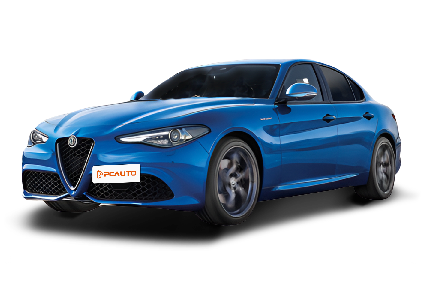Q
What is the safety rating of the Alfa Romeo Giulia Veloce 2019?
The 2019 Alfa Romeo Giulia Veloce received the highest five - star rating in the European New Car Assessment Programme (Euro NCAP) tests. This achievement proves its excellent performance in areas such as adult occupant protection, child occupant protection, pedestrian safety, and safety assist systems. Specifically, it scored as high as 98% in adult occupant protection, and its safety assist systems also reached 60%. This kind of performance makes it a great choice for Malaysian consumers who pursue both driving pleasure and safety.
It's worth mentioning that the Giulia Veloce comes standard with advanced safety features like automatic emergency braking and lane - keeping assist. These features can provide additional safety guarantees in Malaysia's complex urban and highway conditions.
In addition, although the Euro NCAP test standards are strict, Malaysian consumers should also be aware of the differences between the actual driving environment and the test conditions. It is recommended to take a test drive according to their own needs. Meanwhile, the coverage of Alfa Romeo's after - sales service network in Malaysia is also a factor worth knowing before buying a car. After all, regular maintenance is crucial for maintaining the vehicle's safety performance.
Special Disclaimer: This content is published by users and does not represent the views or position of PCauto.
Latest Q&A
Q
What engine is in the 2018 Bezza?
The 2018 Perodua Bezza comes with two naturally aspirated engine options: a 1.0-liter and a 1.3-liter. The 1.0-liter 1KR-VE three-cylinder engine puts out 51 kW of maximum power and 91 Nm of peak torque, while the 1.3-liter 1NR-VE four-cylinder unit delivers 73 kW of max power and 121 Nm of peak torque. Both engines are paired with either a four-speed automatic transmission or a five-speed manual gearbox to suit different driving preferences. These engines are known for their fuel efficiency and reliability, making them especially good for city commuting. The 1.3-liter version stands out with better performance, ideal for drivers who want a bit more pep. The upside of naturally aspirated engines here is their simple construction and low maintenance costs, perfect for budget-conscious buyers who value practicality. Plus, both engines met the emission standards back then, showing Perodua's solid tech in the small car segment. If you're looking at a used Bezza, the 2018 model's engine is steady and routine upkeep is easy, making it a really good value pick.
Q
What engine is in the Mitsubishi Xpander 2023?
The 2023 Mitsubishi Xpander is powered by a 1.5-liter MIVEC four-cylinder naturally aspirated gasoline engine, delivering a maximum output of 105 horsepower and a peak torque of 141 Nm. It comes paired with either a 5-speed manual or a 4-speed automatic transmission. This engine prioritizes fuel efficiency and smoothness, making it ideal for daily family use. As a 7-seater MPV, the Xpander's engine is tuned to emphasize low-end torque, suiting city driving and load-carrying needs. It also features Mitsubishi's MIVEC variable valve timing technology, which optimizes power response and fuel consumption. Among its peers, many competitors like the Toyota Avanza or Honda BR-V also use naturally aspirated engines of similar displacement, but their tuning and technical focuses vary. The Xpander stands out for its high reliability and relatively low maintenance costs, appealing to practicality-minded consumers. For those seeking more power, Mitsubishi offers other models with turbocharging technology, but the Xpander is positioned more towards economy and practicality, targeting family users.
Q
How much is the new Xpander 2023?
The official price of the all-new 2023 Mitsubishi Xpander ranges from RM99,980 to RM111,980, depending on the variant, including the standard Xpander, the high-spec Xpander, and the Xpander Cross. All models are powered by a 1.5L MIVEC naturally aspirated engine paired with a 4-speed automatic transmission, delivering a smooth driving experience. The Xpander is known for its spacious 7-seater cabin and flexible interior layout, making it ideal for families. The addition of the new ADAS advanced driver assistance system further enhances driving safety. This MPV stands out for its value-for-money proposition in its class, especially appealing to consumers who prioritize practicality and comfort. When purchasing, you can also check out the promotional offers from different dealers, such as free maintenance services or low-interest loans. If you're interested in the Xpander, it's advisable to visit a nearby showroom for a test drive to experience its handling and space firsthand. You might also want to compare it with other models in the same category, like the Toyota Avanza or Honda BR-V, to make a more comprehensive buying decision.
Q
How much does it cost to replace a timing belt on a 2018 Honda Civic?
The cost to replace the timing belt on a 2018 Honda Civic typically ranges from RM800 to RM1500. The exact price depends on the type of repair shop, whether original or aftermarket parts are used, and if components like the water pump are replaced at the same time. A genuine belt kit plus a water pump can push the total cost close to RM2000. As a critical engine component, the timing belt should be replaced every 60,000 to 100,000 kilometers or around 5 years. A broken belt can cause catastrophic damage from valve-piston collisions. Beyond the belt itself, professional technicians usually recommend replacing the tensioner and idler pulleys together for system stability. Note that some models use a timing chain design which doesn’t require regular replacement. When choosing a repair shop, verify they use legitimate parts and have Honda-specific experience—improper installation shortens belt life. Regularly checking for cracks or wear on the belt also helps prevent sudden failures.
Q
Is the 2018 Civic a safe car?
The 2018 Honda Civic shines when it comes to safety, packing in a solid lineup of active and passive safety tech. You've got your standard stuff like Vehicle Stability Control, Anti-lock Braking System, multiple airbags, and a rigid body structure—all working together to keep occupants protected when crash tests put it to the test. Step up to the higher trims, and you'll get Honda SENSING, which adds some pretty advanced features: adaptive cruise control, lane keeping assist, and collision mitigation braking, just to name a few. These definitely give peace of mind on the road. Behind the wheel, the Civic feels steady and the brakes are reliable too, making it a solid choice for everyday driving. If you're looking to dig deeper into car safety, checking out crash test ratings is a good move—think ASEAN NCAP or Global NCAP scores. They give you a better overall picture of how a car holds up. And don't forget, regular maintenance—keeping an eye on tires, brakes, and other key parts—is just as crucial for staying safe out there.
View More







Pros
Cons